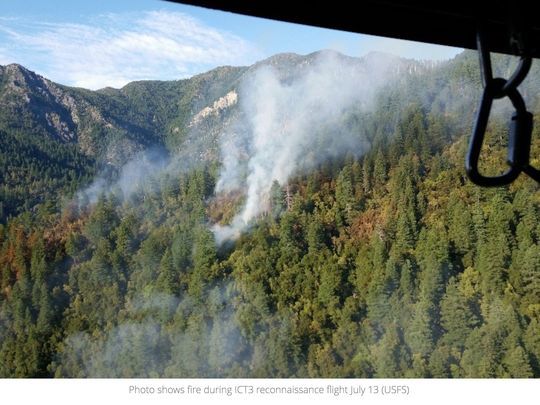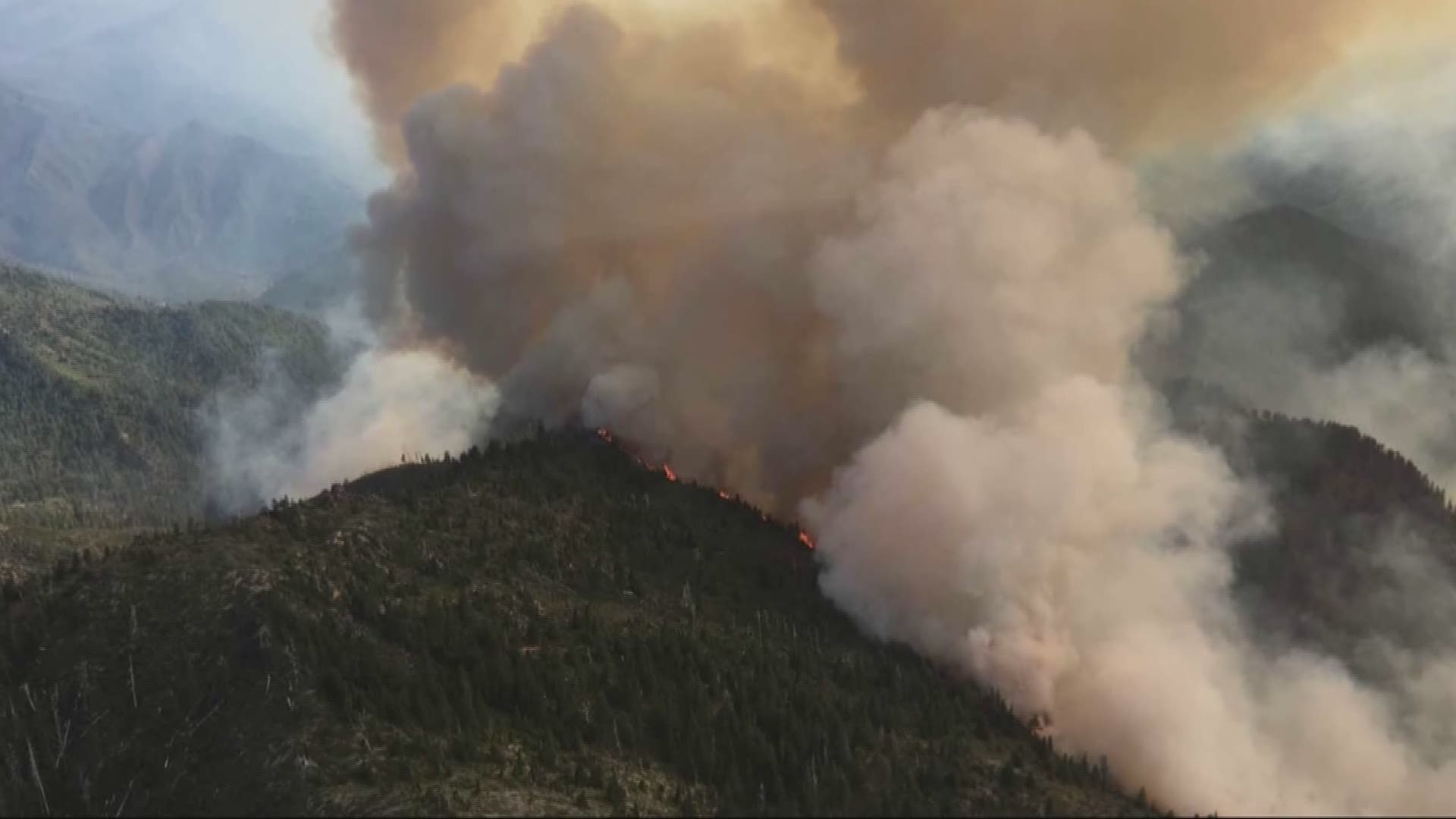BROOKINGS, Ore. -- On the afternoon of July 12, four firefighters dropped from a helicopter into southwest Oregon’s Kalmiopsis Wilderness to try and snuff out a small but challenging wildfire.
The blaze was just a half-acre, but it was located on a mountain so steep that flaming logs and brush were already careening downhill to the Chetco River.
For two days, the team attacked the fire in deep brush, belly-crawling and bushwhacking along the slopes as three helicopters dropped water on the flames, according to a U.S. Forest Service report.
Eventually, they were forced to pull out.
“There were no escape routes, and the fire was dropping a shotgun pattern of spot fires down the hill,” said Monty Edwards, fire management officer for Rogue River-Siskiyou National Forest during a public meeting Thursday in Brookings.
“Somebody was going to get hurt if we stayed engaged in there.”
That day in early July would mark the beginning of the Chetco Bar Fire, a blaze that remained quiet for almost a month before exploding into the nation’s most dangerous wildfire.
Chetco Bar would torch 190,000 acres, burn six houses, force 5,000 people to evacuate their homes and threaten communities from Brookings to Cave Junction.
The fire, now almost entirely contained following autumn rains, has cost $61 million.
At a tense meeting Thursday, Forest Service officials explained decisions they made in fighting the fire to a skeptical crowd.
Brookings resident Cecelia Whorlton spoke of her home burning to the ground and getting no help to save it. Harry Harns said the Forest Service stood by as the fire grew and had learned nothing from past megafires in the same area.
Curry County Commissioner Court Boice told residents not to use profanity during the meeting, but said he wanted answers.
“It was only by the grace of God we didn’t lose Brookings,” he said. “The loss is frankly incalculable and we want our government to tell us what happened.”
A history of wildfire
Wildfire is nothing new in the Kalmiopsis Wilderness.
The best-known infernos include the 2002 Biscuit Fire, which burned 500,000 acres, and the 1997 Silver Fire, which burned almost 100,000.
Both left giant scars of dead snags littered across a landscape highlighted by rugged canyons and clear-running rivers such as the Illinois, Chetco and Smith.
Two smaller fires have burned in the scarred-over forest in recent years, including 2013’s Labrador Fire, which started in a similar manner to Chetco Bar.
Both ignited from lightning strikes in July. Both were located in remote terrain that firefighters decided was too dangerous to directly attack.
“When you can’t safely put firefighters right on the fire, you back off and put containment lines around it so you can fight the fire on more favorable ground,” said John Prendergast, a wildfire safety officer who worked Chetco Bar.

That strategy worked well on Labrador, which slowly burned itself out at 2,500 acres, Prendergast said.
“No firefighters were directly exposed, it never made a run and it cost very little to fight,” he said. “We were hopeful the same strategy would work on Chetco Bar.”
For a while, that seemed to be the case.
The fire reached 5,400 acres on Aug. 15, more than a month after the initial attack. No fire teams directly attacked the flames.
Edwards told the Curry County Pilot newspaper, on July 28, that Chetco Bar would likely be allowed to burn itself out.
“Unfortunately,” Prendergast said. “The weather caught up with us.”
Catastrophe
The local winds, known as the “Chetco Effect,” showed up for the first time the evening of Aug. 15.
Then, things went haywire.
The fire had already been aided by a long period of hot and dry weather with little nighttime humidity. Now, the Chetco winds added a blast-furnace of 45 MPH to the flames.
The first sign came Aug. 17, when the fire jumped to the Chetco River’s south bank and reached 8,500 acres.
Over the next few days, the fire would rip across 18 miles in 80 hours.
The fire burned six homes in the Gardner Ridge and Cate Road areas east of Brookings, hitting 48,825 acres Aug. 19.
“My family lost everything except our pictures and our clothes,” Cecelia Whorlton said during Thursday’s meeting. “We were not protected or given any help.”
The fire blew right across fire lines, darkening the noontime sky in Brookings and blowing smoke clouds the size of thunderheads over the ocean.
By Aug. 22, the fire had doubled to 100,000 acres.
Click here for acreage burned by date. Story continues below
“It was some of the most amazing, scary, fire behavior I’ve seen in 38 years,” Prendergast said. “We’d factored the Chetco winds into modeling used to predict fire growth. But the fire significantly outpaced anything we expected.
“There was about a 0.2 percent probability of the fire growing that fast. It was just a perfect combination of factors — dry fuel, hot temperatures, little moisture and those Chetco winds.”
The Oregon State Fire Marshal activated the Conflagration Act Aug. 20, boosting the number of people working the fire to 1,174, from just 280 two days earlier.
Luckily, the Chetco winds died down.
Even so, residents across southwest Oregon were blanketed in smoke that dropped air quality to “hazardous” levels for days at a time.
“The air today was almost unbearable,” Brookings resident April Bowen said on Aug. 27. “We couldn’t see the mountains or the ocean through the smoke.
“With burning eyes and stuffed up noses, this community rallied together to help each other.”
An evacuation warning was issued for Brookings as emergency managers planned how they’d actually move out the town of 6,500 people.
In the meantime, more than 5,000 were displaced from their homes closer to the fire, opening temporary shelters everywhere from schools to state parks.
Late August would mark the scariest time in the Brookings area. The fire never got closer than five miles of the coastal town, although it would continue to plague the area with smoke.
For the most part, the fire grew to the east, south and north. It sparked evacuations in the Illinois Valley after moving within 8 to 10 miles of Cave Junction.
Now, following September’s heavy rain, the Chetco Bar Fire has cooled significantly. Teams are just beginning to assess the damage.
At the meeting, Commissioner Boice expressed a desire to move on while also taking a hard look at forest and wildfire fighting policies.
“We want to move forward and look at doing everything we can to avoid these megafires,” he said. “It will take all of us.”
Note: For the U.S. Forest Service's full report, see here.
Zach Urness has been an outdoors writer, photographer and videographer in Oregon for nine years. Urness lived in southwest Oregon for five years and still loves the area. He can be reached at zurness@StatesmanJournal.com or (503) 399-6801.

